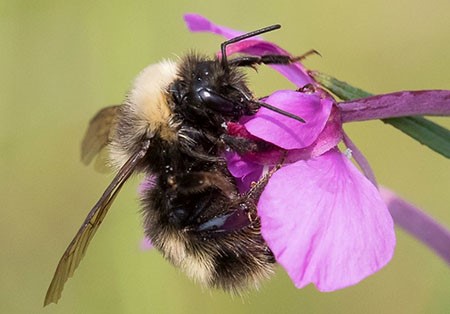Statewide Environmental Office
Pollinator Program
Pollinators
Pollinators are an important part of Alaska's ecosystems and economy. They facilitate fertilization in fruits, vegetables, and all flowering wild plants by transferring pollen from one flower or plant to another. Only fertilized flowers can produce fruit or seeds! From the rainforests of Southeast Alaska to the tundra of the North Slope, pollinators enhance the state's spectacular scenic grandeur. These species are also crucial for farmers and gardeners – without them, we wouldn't have bountiful harvests of Alaska-grown crops or abundant wild berries.

Pollinators include:
- Bees
- Butterflies
- Birds
- Bats
- Flies
- Mosquitos
- Beetles
Threats to pollinators have increased in recent years, including habitat loss, pesticide and herbicide use, and disease. These impacts have led to significant population declines in several pollinator species. To ensure that these vital species have the necessary resources to thrive and maintain their population levels, transportation agencies across the U.S. have established programs within their departments to create, enhance, and preserve pollinator habitats. With this concerted effort in mind, the Alaska Office of the Governor annually designates June 17-23 as Alaska Pollinator Week, and the Alaska Department of Transportation and Public Facilities (DOT&PF) has launched a Pollinator Habitat Program.
Pollinator Habitat Program
The DOT&PF Pollinator Habitat Program supports the protection and enhancement of natural areas along state-maintained roads and properties. This is achieved through research, planning, initiation, and evaluation of conservation measures and related best management practices (BMPs). Pollinator-friendly BMPs are implemented on both right-of-way maintenance projects and new construction projects, and include:
-
An integrated vegetation management plan (IPM) that includes mechanical tree and shrub removal, as well as targeted and judicious use of herbicides to manage and control invasive non-native plant species
-
Native plant salvage and native seed mixes for revegetation of construction projects
Pollinator-friendly BMPs facilitate revegetation of natural plant species to reduce the introduction and spread of invasive species and provide native habitat for a variety of pollinator species. These BMPs ensure Alaska's wild and scenic landscapes along our roadways and airports are maintained for future generations.
Benefits of Pollinator Habitat
In addition to providing habitat for important pollinator species, pollinator habitat provides the following benefits:
-
Establishment of native plant ecosystems rather than invasive species
-
Long-lasting vegetative stormwater management and erosion control
Research Efforts
With pollinating insect populations like bees and butterflies declining, DOT&PF seeks new opportunities to enhance its native seed mix with native flowering plants to establish and conserve pollinator habitats along its rights of way.
Additional Resources
Alaska Department of Fish and Game information about the western bumblebee: https://www.adfg.alaska.gov/index.cfm?adfg=wildlifenews.view_article&articles_id=995
USFWS pollinator gardens: https://yakutattlingittribe.org/wp-content/uploads/2019/12/Planting-a-Pollinator-Garden.pdf
Environmental Info
3132 Channel Dr.,
P.O. Box 112500
Juneau, AK 99811-2500
Phone: (907) 465-4225
Doug Kolwaite
Statewide Environmental Program Manager
